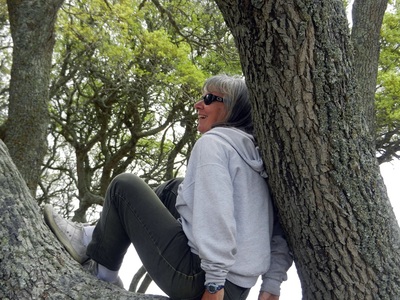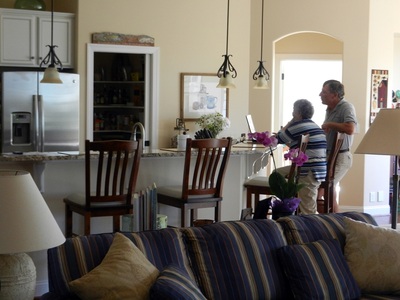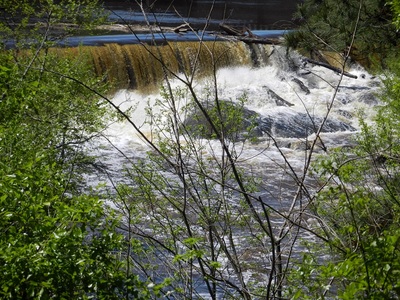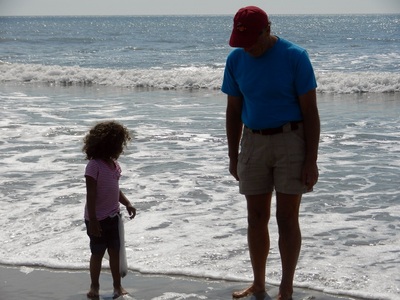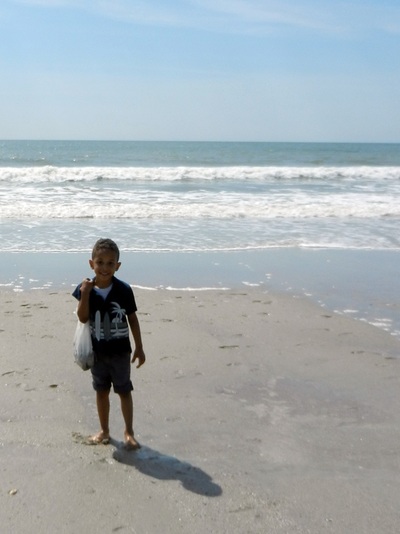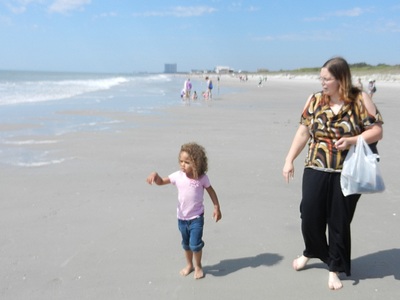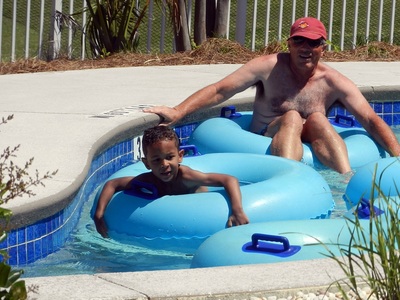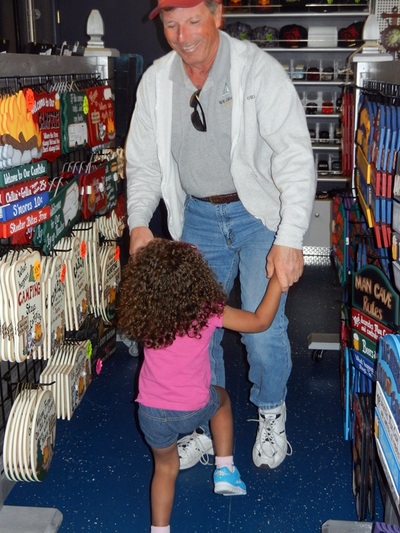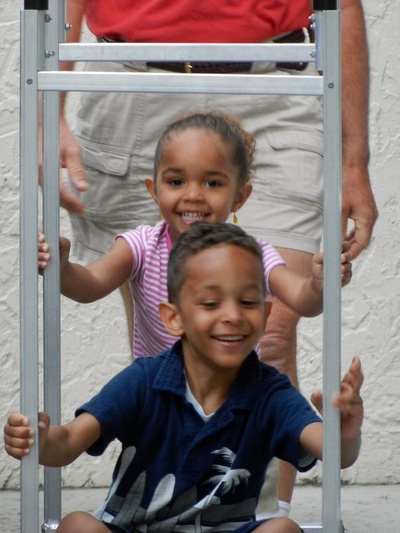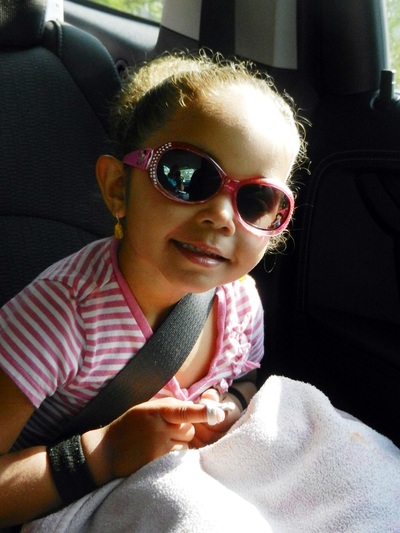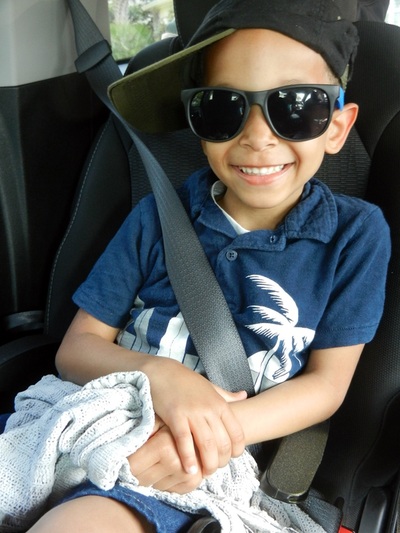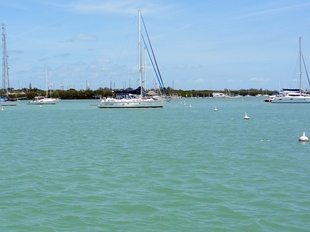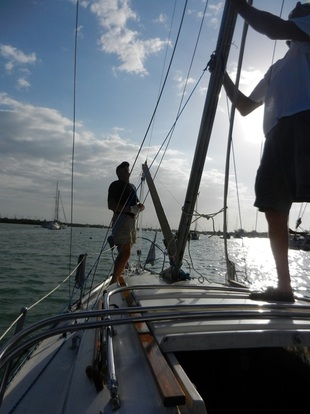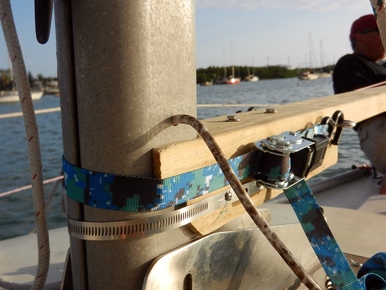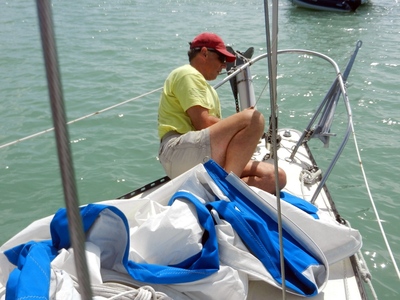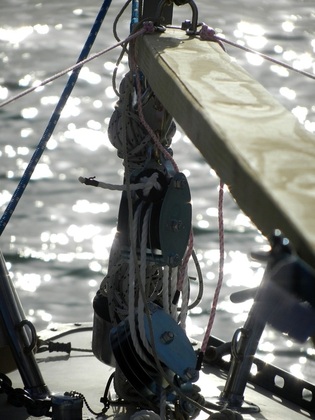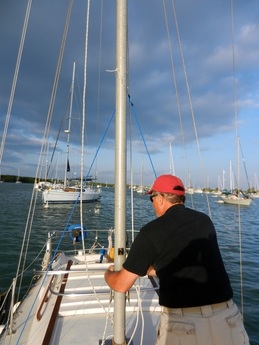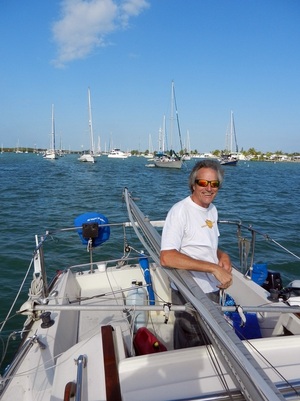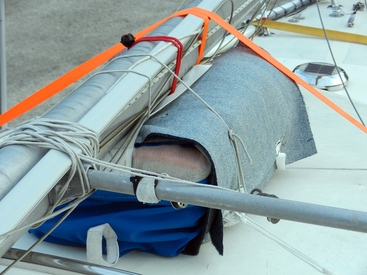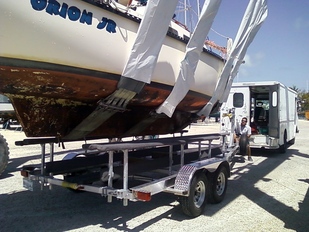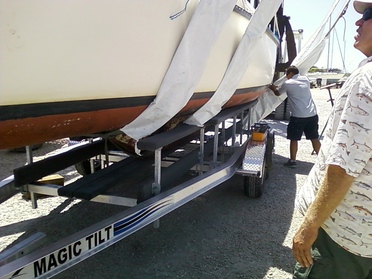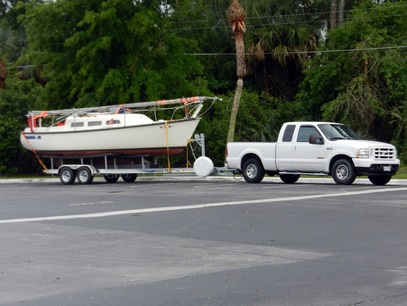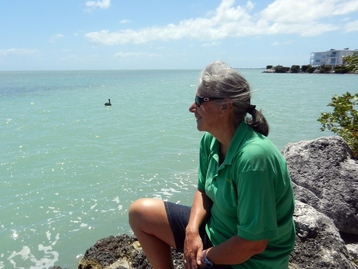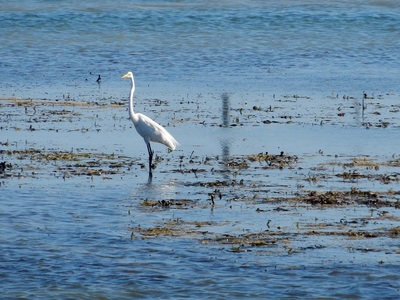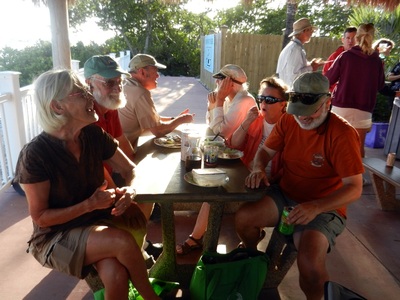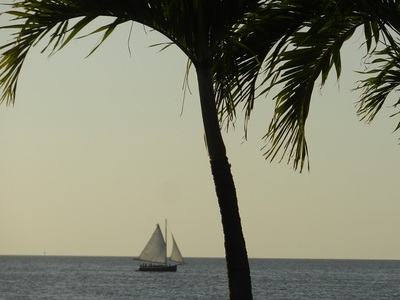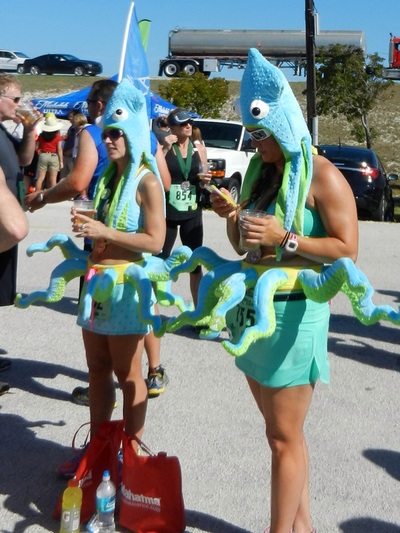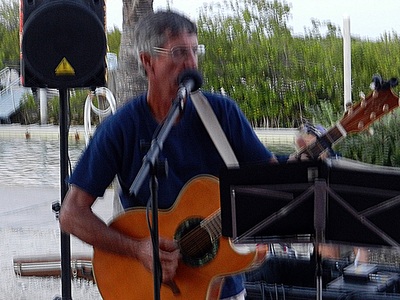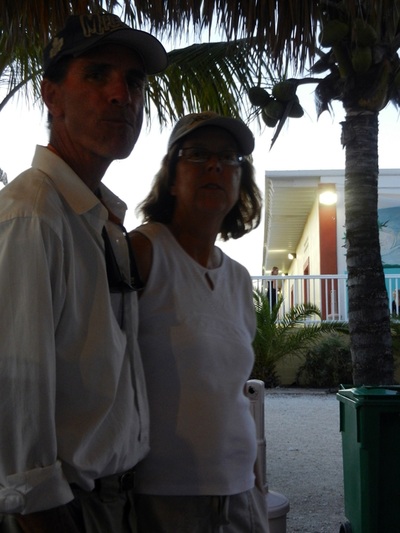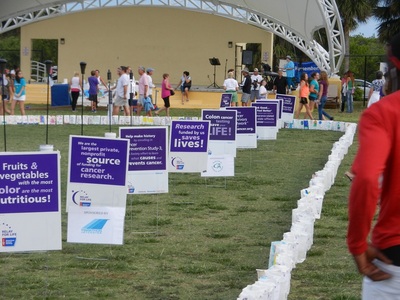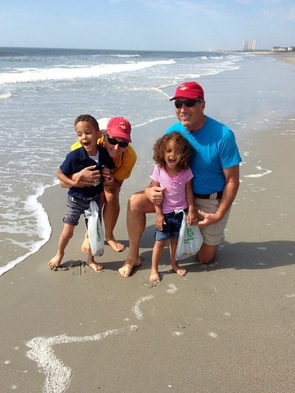 Beach time with Troy and Taylor
Beach time with Troy and Taylor Orion Jr has never travelled so fast – 60+ mph. Wow!. That being said, despite the 10-fold increase in speed, it still took us over 2 weeks to make it back to Hampton. Needless to say, there were a few stops along the way – Daytona for some outboard maintenance (and chocolate), Wilmington, Myrtle Beach and New Bern to visit with friends and family. And the trailer, boat, and her owners made it all in one piece.
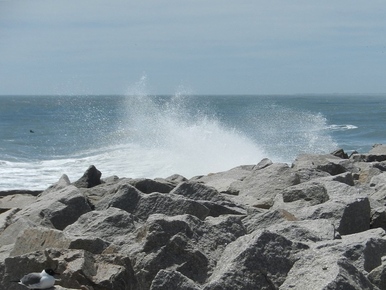 Waves pounding beach off Ft. Fisher in NC
Waves pounding beach off Ft. Fisher in NC Going to windward
We've often heard the joke that nothing goes to windward like a 747. Just substitute a Ford F250 for the 747. Each hour driving north, we covered more than a day's travel for Jr by water. So, our first stop, Daytona Beach, was the equivalent of 7 or 8 days of travel by boat.
With several tons of boat and trailer behind us, logistics for the trip became more complicated. Stops for fuel needed to be truck stops. Hotels needed to have large vehicle parking, preferably with pull-through spots. Rest areas were the favorite rest stops. Careful consideration was needed when pulling into parking spaces. There was no way we were going to be able to manhandle this trailer into a tight spot. The truck would need to do the work.
Once we finished the first highway trip, our first peek inside the boat showed we had stowed everything well for the normal side to side motion we were used to, but hadn't considered the momentum of things moving forward when the trailer comes to a more sudden stop. Some well-placed bungees kept the storage drawers in place for future legs. Then there was the rain. When it's coming down at 60mph, it finds new ways to get inside. There were some odd water trails, but nothing excessive. Another surprise was the dirt all over the main saloon inside the boat. We had expected this to be all over the exterior. Hmmm. . . Outside, the boat tie-downs and those for the mast and bimini supports all held well, but we found that we needed to add some chafe protection to the rear boat straps to keep them from damaging the hull. The flags are not working out well either, so we'll need to get something more durable for the long term. Although they did provide an unexpected benefit. The mount for the windex and mast light broke off while underway and was caught in one of them. So, we were able to retrieve it and keep it from damaging some vehicle behind us.
It wasn't too bad for a first trip. There still a lot to learn in moving the trailer around and getting it to go exactly where we want it, but we have time to gain more experience.
We've often heard the joke that nothing goes to windward like a 747. Just substitute a Ford F250 for the 747. Each hour driving north, we covered more than a day's travel for Jr by water. So, our first stop, Daytona Beach, was the equivalent of 7 or 8 days of travel by boat.
With several tons of boat and trailer behind us, logistics for the trip became more complicated. Stops for fuel needed to be truck stops. Hotels needed to have large vehicle parking, preferably with pull-through spots. Rest areas were the favorite rest stops. Careful consideration was needed when pulling into parking spaces. There was no way we were going to be able to manhandle this trailer into a tight spot. The truck would need to do the work.
Once we finished the first highway trip, our first peek inside the boat showed we had stowed everything well for the normal side to side motion we were used to, but hadn't considered the momentum of things moving forward when the trailer comes to a more sudden stop. Some well-placed bungees kept the storage drawers in place for future legs. Then there was the rain. When it's coming down at 60mph, it finds new ways to get inside. There were some odd water trails, but nothing excessive. Another surprise was the dirt all over the main saloon inside the boat. We had expected this to be all over the exterior. Hmmm. . . Outside, the boat tie-downs and those for the mast and bimini supports all held well, but we found that we needed to add some chafe protection to the rear boat straps to keep them from damaging the hull. The flags are not working out well either, so we'll need to get something more durable for the long term. Although they did provide an unexpected benefit. The mount for the windex and mast light broke off while underway and was caught in one of them. So, we were able to retrieve it and keep it from damaging some vehicle behind us.
It wasn't too bad for a first trip. There still a lot to learn in moving the trailer around and getting it to go exactly where we want it, but we have time to gain more experience.
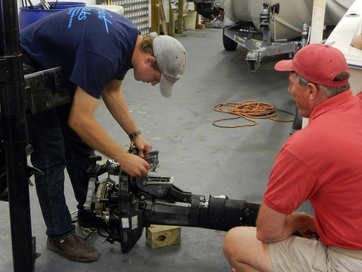 Blake works to remove stubborn pin, while Dave looks on
Blake works to remove stubborn pin, while Dave looks on Outboard School
While in Daytona, we scheduled some time with Blake at Barefoot Boats to do some maintenance on our 2 outboards. They were running fine, but overdue for a tune-up. Blake had offered to let Dave watch and learn what he could about how they worked and how to maintain them. (Cathy came along to "document" and tried to stay out of the way.) We had never been to Blake's shop before, but it was impressive – a huge space that was almost completely full of boats he and his mechanics were working on. And there was another space next door for fiberglass work that we didn't even see. As we worked through the maintenance and repairs on the motors, we also saw that he had the right tool for every task. And how that made some difficult tasks much easier.
While in Daytona, we scheduled some time with Blake at Barefoot Boats to do some maintenance on our 2 outboards. They were running fine, but overdue for a tune-up. Blake had offered to let Dave watch and learn what he could about how they worked and how to maintain them. (Cathy came along to "document" and tried to stay out of the way.) We had never been to Blake's shop before, but it was impressive – a huge space that was almost completely full of boats he and his mechanics were working on. And there was another space next door for fiberglass work that we didn't even see. As we worked through the maintenance and repairs on the motors, we also saw that he had the right tool for every task. And how that made some difficult tasks much easier.
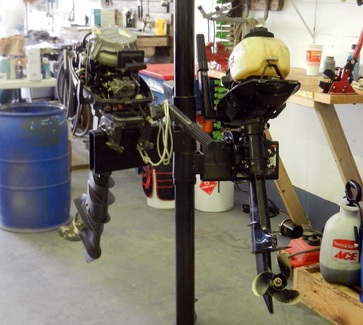 Both outboards are open and waiting to be worked on.
Both outboards are open and waiting to be worked on. As for the work at hand, we started with the Nissan 9.8 2-stroke outboard that powers Orion Jr. It came with Jr so we don't know too much about its history and we're not sure how old it is. However, it has done really well with a minimum of maintenance. We still had a couple of issues with it. The throttle wouldn't hold the position at a set rpm, which made it frustrating when motoring long distances or even when trying to approach a dock at a constant speed. Also, it was becoming harder to raise and lower the engine. The one enhancement we were looking for was to add the wiring for a tachometer, so we could more reliably know how to adjust it for optimum speed and fuel consumption.
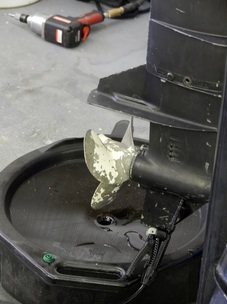 Draining oil from Nissan
Draining oil from Nissan Before addressing the fixes and enhancements, Blake changed the spark plugs, drained and changed the oil in the lower unit, changed the impeller and greased the lower unit. He gave some tips that made these steps easier. Put the engine in gear before changing the impeller. That way, when re-installing, you turn the prop slightly to install and the fins will move naturally into the right direction. Using a #3 slotted screwdriver is important, because it fits snugly into the screw for the lower unit oil. This makes removing the screw easier and it is less likely that you will strip it.
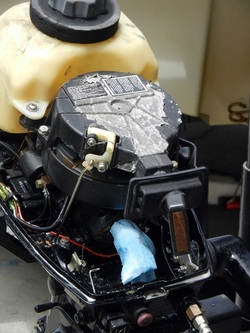 Mercury outboard after cleaning
Mercury outboard after cleaning Our other engine is a 4hp Mercury 2-stroke that is for our dinghy. We bought it new in 2005 before we started cruising, and it has been our workhorse ever since. It also needed the same tune-up, but FIRST it needed to be cleaned. The foam inside the case had disintegrated and was everywhere. Also, there was a lot of oil in the base of the inside. After cleaning the inside, Blake changed the oil, impeller, grease and spark plugs. Since this one had been running a little rough, he cleaned the carburetor. Dave had been having nuisance problems with the external fuel connector chafing and leaking (which was probably the source of the gunk that he cleaned out), To correct this, Blake replaced the hose with a stiffer grade and covered it in heat shrink for extra protection. That's all it needed. After running it in the test tank, we were ready to go.
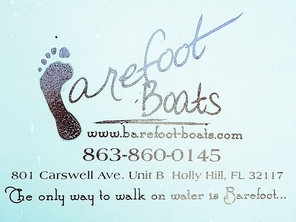
It was a good experience all-around. We learned a lot about the engines and feel more confident if something should go wrong that we'll know how to fix it. Blake's knowledge and experience is impressive, and his business shows it. It's well run and he has lots of work. If you're ever in Daytona and need some work done, give him a call.

Sweet Times
Passing through Daytona the week before Easter meant stopping at Angell and Phelps was a higher priority than normal. Stocked with chocolate bunnies, we were fortified for our trip north. With some help in finding a spot to park Jr along the way, we were able to spend time with friends and family as we traveled.
Passing through Daytona the week before Easter meant stopping at Angell and Phelps was a higher priority than normal. Stocked with chocolate bunnies, we were fortified for our trip north. With some help in finding a spot to park Jr along the way, we were able to spend time with friends and family as we traveled.
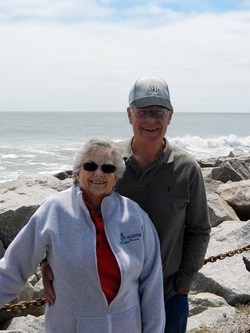 George and Gail at Fort Fisher
George and Gail at Fort Fisher George and Gail Braun put us up in their new home on Easter weekend in the Brunswick Forest development just south of Wilmington. We enjoyed the visit, getting to spend time catching up, sightseeing and attending their church for Easter Sunday services. In exchange for their hospitality, we spent some time straightening out some computer problems. In the process, some of Gail's older (say 6 month) e-mails were inadvertently sent to some recipients who were scratching their heads as pictures of the house regressed to its under-construction state. It made for some good laughs as the recipients responded.
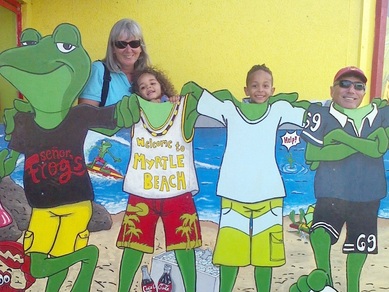 Having fun in Myrtle Beach
Having fun in Myrtle Beach We were then well-positioned to join our daughter's family at Myrtle Beach for the week after Easter. The rainy weekend was replaced with wonderful warm weather – good for fishing, shelling and swimming in the pool. The ocean was a little cold for our tastes. We had a great week enjoying their company and providing some babysitting while Mom and Dad got some time out on their own.
From there we moved back north to pick up Orion Jr, intending to make the drive to Hampton, but we were waylaid once again and decided to stop by New Bern to see Skip and Cherylle. Skip was working hard on his new project, Annie Bell, a 30 foot Oday that was looking pretty sharp. Dave offered a hand with a few 2-person projects in preparation for her maiden voyage the following weekend.
But we needed to actually finish this trip, so on the last day of April, we arrived in Hampton and began turning our attention to Orion once again, until we take Jr on the road again. She seems to like going to windward this way.
From there we moved back north to pick up Orion Jr, intending to make the drive to Hampton, but we were waylaid once again and decided to stop by New Bern to see Skip and Cherylle. Skip was working hard on his new project, Annie Bell, a 30 foot Oday that was looking pretty sharp. Dave offered a hand with a few 2-person projects in preparation for her maiden voyage the following weekend.
But we needed to actually finish this trip, so on the last day of April, we arrived in Hampton and began turning our attention to Orion once again, until we take Jr on the road again. She seems to like going to windward this way.
